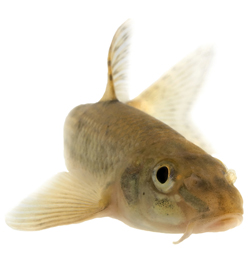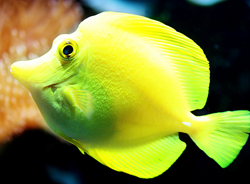|
||||||||||||||||||
Fish Feel PainScience has repeatedly shown us what common sense already tells us: Fish feel pain and can suffer. Dr. Temple Grandin, PhD, PAS, considered the world's leading expert on farmed-animal welfare and an advisor to the U.S. Department of Agriculture and the meat industry, states, "Research shows that fish respond to painful stimuli in a manner that is not just a simple reflex." i The evidence is so clear that world leaders are taking notice. The Standing Committee of the European Convention for the Protection of Animals Kept for Farming Purposes explains, "The skin of the fish is the first line of defence against disease and provides protection from the environment. It contains sensory receptors for touch, pressure and pain." ii
When they are impaled on a hook, fish don't scream or grimace, though their gaping mouths may evoke a look of shock or horror to the empathetic witness. Using facial expression as a guide for sentience is hardly valid when one considers that some of the most intelligent and highly sentient marine vertebrates – namely the dolphins and whales – also lack facial expression, at least any that most of us can readily detect. However, animals have many other ways of visually signaling their feelings. Crests, dewlaps, mouth-pages, pupil dilation and contraction, color changes, and body postures and movements are among the many visual ways fish and other animals convey emotions. Water is also a potent medium for communicating via chemicals and sounds.
A recent study found that when noxious substances were applied to the lips of trout, the fishes' heart rates increased, and they took longer to resume feeding. These fish also exhibited unusual behaviors after being harmed, including rocking from side to side while balanced on their pectoral fins, and rubbing their lips into the gravel and against tank walls. Treatment with a pain suppressant significantly lowered these effects. Other experiments have found that fish learn to avoid unpleasant stimuli such as electric shocks, and piercing of their lips by sharp hooks.
Recent research has demonstrated that fish have nociceptors, receptors on the skin that preferentially detect noxious, potentially painful stimuli. These nociceptors are physiologically similar to those found in mammals. Areas of the brain, such as the forebrain and midbrain which are important in mammalian pain processing, are active during the application of painful stimuli and have been imaged using fMRI and have been recorded to exhibit electrical activity and molecular changes. Suspension of normal behaviour and adverse changes in physiology are also exhibited by fish subject to a painful stimulus in vivo which is dramatically reduced by the use of painkillers or analgesia. ... These results suggest that painful, noxious stimulation is important to fish.
A study published by the University of Edinburgh's Division of Biological Sciences concluded that fish meet all of the same criteria set forth for the capacity to feel pain as humans and other animals: What an animal "feels" is possibly nothing like the experience of humans with a more complex brain structure, however, the animal's experience may be unpleasant or cause suffering and their discomfort is no less important in terms of biology or ethics … [T]o show that this [aversive response] is not simply a nociceptive reflex, it is necessary to show that the animal learns that the stimulus is associated with an unpleasant experience and avoids it. Certainly it has been demonstrated that fish can learn to avoid an adverse stimulus such as electric shock … and hooking during angling … The results of the present study demonstrate nociception and suggest that noxious stimulation in the rainbow trout has adverse behavioural and physiological effects. This fulfils the criteria for animal pain.v
Most important, assuming that animals do experience rich emotions will never cause any harm. A lovely, unidentified quotation captures this well: "If I assume that animals have subjective feelings of pain, fear, hunger, and the like, and if I am mistaken in doing so, no harm will have been done; but if I assume the contrary, when in fact animals do have such feelings, then I open the way to unlimited cruelties … Animals must have the benefit of the doubt, if indeed there be any doubt."
As John Webster, Emeritus Professor of Animal Husbandry of the University of Bristol's Department of Clinical Veterinary Science, argues, "to say that a fish cannot feel pain because it doesn't have a neocortex is like saying it cannot breathe because it doesn't have lungs." Put simply, fish possess pain receptors, their brains produce natural painkillers (endogenous opioids) and they avoid noxious and threatening stimuli. Such aversive behaviors are also often learned – not merely reflexive. In the nascent field of fish ethology, fish are proving to be amazingly complex individuals. i Grandin, Temple. 2010. The Importance of Measurement to Improve the Welfare of Livestock, Poultry and Fish. In: Grandin, Temple (ed.). 2010. Improving Animal Welfare: A Practical Approach. Cambridge University Press: Cambridge, pp. 1-20.
| ||||||||||||||||||
 In his book
In his book  In 2009, Applied Animal Behaviour Science reported on a study of unanesthetized goldfish conducted by Purdue University's Department of Animal Sciences. Purdue Associate Professor Joseph Garner, who obtained his DPhil from Oxford University, describes the experience of the animals in their experiment: "The goldfish that did not get morphine experienced this painful, stressful event. Then two hours later, they turned that pain into fear like we do. To me, it sounds an awful lot like how we experience pain." iv
In 2009, Applied Animal Behaviour Science reported on a study of unanesthetized goldfish conducted by Purdue University's Department of Animal Sciences. Purdue Associate Professor Joseph Garner, who obtained his DPhil from Oxford University, describes the experience of the animals in their experiment: "The goldfish that did not get morphine experienced this painful, stressful event. Then two hours later, they turned that pain into fear like we do. To me, it sounds an awful lot like how we experience pain." iv
 In his essay "The Evolution of Pain," Dr. Donald Broom, University of Cambridge professor of animal welfare in the Department of Clinical Veterinary Medicine and vice-chair of animal welfare for the European Commission's Scientific Committee on Animal Health and Animal Welfare, cautions, "It is necessary to look for the site of any particular function rather than assuming that it will be in the same area as in man" and concludes that "it is not logical to assume that, because an area which has a certain function in man is small or absent in another group of vertebrates, the function itself is missing."
In his essay "The Evolution of Pain," Dr. Donald Broom, University of Cambridge professor of animal welfare in the Department of Clinical Veterinary Medicine and vice-chair of animal welfare for the European Commission's Scientific Committee on Animal Health and Animal Welfare, cautions, "It is necessary to look for the site of any particular function rather than assuming that it will be in the same area as in man" and concludes that "it is not logical to assume that, because an area which has a certain function in man is small or absent in another group of vertebrates, the function itself is missing."